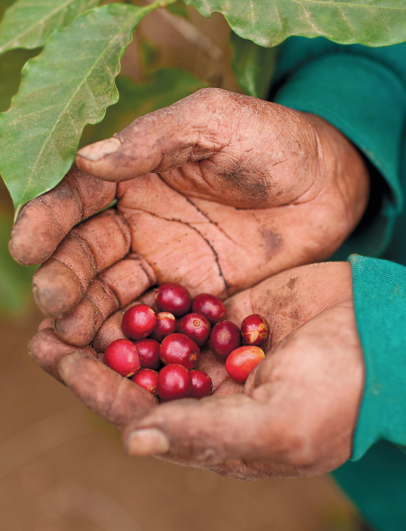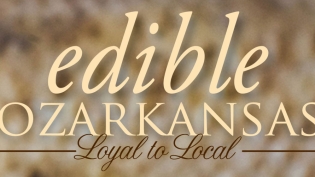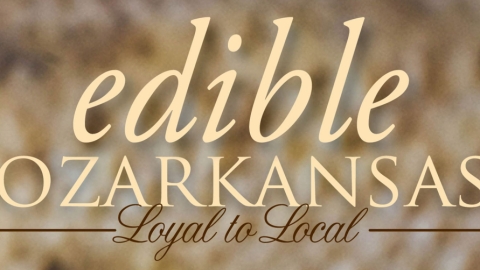Beyond Fair Trade
On the day of our meeting, Mark Bray of Airship Coffee has just offered me a cup of coffee and is now staring with a perplexed expression on his face at one of the ubiquitous single-serve coffee makers that appear in so many corporate offices. If we were in his Bentonville warehouse, which is lined with pallets of direct imported green coffee, freshly roasted coffee beans, as well as an impressive array of La Marzocco espresso machines, it would be a different story. However, he is undaunted: “Put me in a room with hot water and coffee, and I’ll figure it out!”
There is no doubt that coffee culture has reached a fever pitch, and it’s easy to make the assumption that the market – any market – is saturated. But talking with Bray, it becomes obvious that the specialty coffee industry is only just getting started in Northwest Arkansas.
A Brief History of Coffee
While tales of the origin of coffee date as far back as the 6th century, it is generally accepted to have debuted around the 13th century, and Ethiopia is widely agreed upon as the birthplace of coffee. By the 1500s, coffeehouses were common in the Middle East and North Africa, although the consumption of coffee was frowned upon and even banned by various religious institutions due to its stimulating effect. Nonetheless, its popularity grew quickly throughout Europe in the 1600s and travelled to the Americas in the 1700s, where its cultivation became a thriving industry for many Caribbean, Central, and South American nations and remains as such in modern times.
The ritual of coffee served as a comforting blanket of security and consistency during times of conflict for soldiers far flung around the globe, particularly during World War II and the Vietnam War. By the 1970s, when a certain Seattle-based coffee powerhouse turned the phrase referring to coffeehouses as a “third place” between work and home, meeting for a cuppa had become a commonplace activity and coffee’s place in daily culture was well-ensconced.
Despite now being a hallmark for gatherings and a vehicle for connecting people, coffee often traveled along a path marked by turmoil: from poor working conditions on plantations resulting in massive uprisings and revolutions, to the clearing of rain forests for production affecting and shaping the landscape of many countries in The New World.
There is a well-known divide between coffee producing nations – which are predominantly developing countries – and the individual who ultimately consumes the end product, typically in an industrialized nation. Today, coffee “coyotes” in many countries serve as the middle men between small coffee farms and exporters, importers, roasters, and retailers, often to the detriment of the farmers.
The Lencas of Theopalaca Mountains
Airship Coffee is a quality-focused, artisan coffee roaster and a direct importer. Bray is an agriculturalist who found his niche in roasting coffee. His initial interest began percolating in college, when he had to complete an assignment for a plant-breeding class related to an unfamiliar crop. He selected coffee since he already had plans to travel to the coffee lands that summer to do some agricultural outreach with farmers in the Opalaca Mountains of Honduras.
In the particular area of western Honduras that Bray was visiting, there is a large concentration of indigenous Lenca Indians. The tribe retreated into the mountains during a conflict with the Spanish in the 1500s led by their chief Lempira, for whom Honduras renamed its currency in 1931.
In preparation for his trip, Bray began studying coffee breeding and conducted a preliminary visit to investigate the community and its culture. He also threw himself into studying a method known as SALT (sloping agricultural land technology), which is useful for growing in areas typically affected by erosion.
He recalls driving with a Nicaraguan guide named Pedro as far into the mountains as possible, and then, after driving became impossible due to torrential rain and inclement weather, hiking for five hours up into the Opalacas to share this method. They passed a few guys walking on the trail with a radio and learned a hurricane was essentially upon them.
Santos and Maria Juana
They finally made it into a village where the leader, Santos, and his wife, Maria Juana, walked them around their farm and shared their coffee production, cacao, and all kinds of fruits and vegetables.
“We had been hiking all day long, and I hadn’t had any coffee,” says Bray. “I had a headache that was grabbing hold of the back of my neck, and, ironically, I was surrounded by coffee trees.”
He and Pedro were taken to the home of their hosts – a mud hut with no beds, no running water, wooden benches for sleeping, and a grass thatch roof. Maria Juana began cooking over an open fire, roasting coffee and grilling plantains in a comal, which is a flat steel griddle.
Bray recalls that the rain was pouring down outside, and there was a hazy smoke from the fire inside the mud hut. Maria Juana began grinding the coffee beans, and the aromatics nearly killed him – having had nothing to eat or drink all day, it was all starting to go to his head. When he was asked how he would like his coffee, he asked to have it just as they would drink it. And so, Maria Juana took out a machete, grabbed a piece of sugarcane, whacked it in half, and squeezed the fresh sugar juice into the cup.
Sitting there in the mud hut under the rains of the hurricane with those coffee farmers, Bray recalls that it was the very best cup of coffee he’s had to this day and that, in that moment, he was exactly where he was supposed to be.
And that was it. Even today, he isn’t sure whether it was that experience or the coffee, but it was the beginning of his life’s work. “As we sat there discussing how we could work together, they were meeting my needs with the simple offering of a cup of coffee. I was not yet meeting theirs, but I realized it was what I was supposed to be doing with my time. It’s the experience, and the coffee, and the story, and working directly with these people, meeting one another’s needs.”
At the Base of the Lime Tree
He realized he was in the right place, and that day was the beginning of five years of outreach to those communities in the mountains of Honduras. He led teams who returned each summer to build raised beds and implement the SALT system. Word began to spread about their visits, and leaders from 12 neighboring communities began showing up – one of them walked two days to get there.
One day after Bray and the local farmers had been working together all day in the fields, they sat down together under a lime tree and began chatting. He asked his friends where they sold their produce and coffee and how much they were paid for their crops, and the farmers’ response revealed that he and the other team members visiting the Opalacas to do hunger relief work were focusing on the wrong problem.
“We thought growing food was the issue, but these people weren’t hungry because they couldn’t grow food. They were excellent farmers. They were hungry because they weren’t making any money, and they were stuck in a value chain with only one buyer for their cash crop.”
His focus changed immediately to opening up access to the product and improving its quality. He began seeking roasters to open up market access for the Honduran farmers, and even began roasting coffee in his garage and handing out samples to family and friends. Soon, he had acquired a commercial roaster and started making his way into commercial coffee and to other farming communities. Today, Airship Coffee works with farmers in Colombia, Guatemala, Honduras, El Salvador, Burundi, and Ethiopia.
Buzzing in Bentonville
“Because I live in downtown Bentonville, I really value the community,” says Bray. “That had a lot to do with our desire to bring the business to downtown Bentonville. We’re really excited about the culinary movement that’s taking place throughout Northwest Arkansas and want to help create awareness of coffee’s rightful place in the culinary arts.”
The team at Airship Coffee is committed to coffee education and helping others understand where their coffee comes from, which is timely: the Specialty Coffee Association of America recently released a study exploring consumer coffee “behaviors, motivations and perceptions.” Bray says it is to be expected that the more education one receives as a coffee drinker, the more their preferences become ref ined along with that knowledge. The discriminating consumer is looking for something more, which is increasingly becoming known as “super specialty coffee.”
Airship focuses on helping growers produce better cof fee, applying themselves unwaveringly to the craft of roasting, and sharing their passion for coffee with others. They are working to build relat ionships around coffee and to contribute – person by person – to communit ies. Ultimately, Bray and his team aim to connect each coffee drinker to the farmer. And it doesn’t hurt that they are turning out some of the best coffee around.
The passion Bray and his crew at Airship exhibit for every step of the journey a coffee berry takes from field to cup is evident, and they’re pouring it into each bag of coffee. “This feels like the essence of the American dream. I don’t think it’s a two-car garage, a boat and the chance to fish whenever you want. I think it’s the freedom to do what you love, and the opportunity to earn an honest living doing it. The American dream is doing something you love.”






